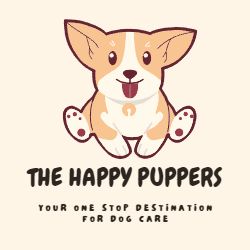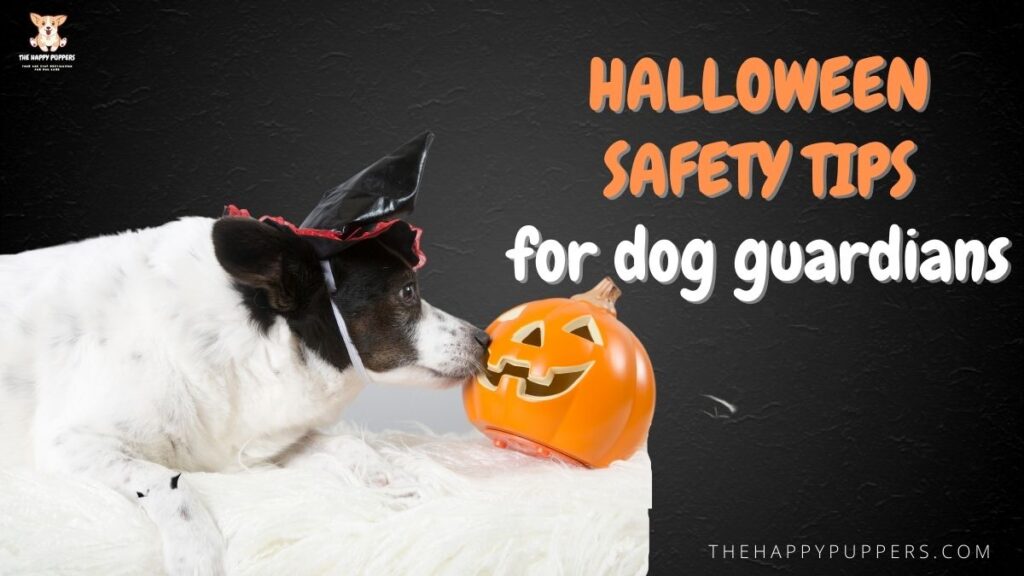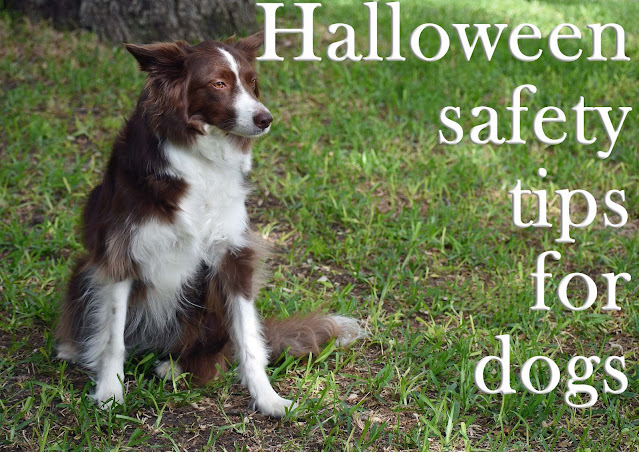Topics covered in this blog post
How to keep your pup safe during Halloween. 7 amazing Halloween safety tips for dogs
Most often, dog guardians get scared when they hear the name of Halloween. They worry for their dog’s safety and health. However, you can make this Halloween safe for your dog by following a few simple tips. Read all the way to the end to know all the Halloween safety tips for dogs.
Understand your dog’s perspective
A dog first instinct is to protect his or her home and alert you in the presence of a stranger. The constant ringing of the doorbell or knocking of the door for trick-or-treating can cause a lot of stress to your dog. Thus, before the start of trick-or-treating, allow your dog to go into a quiet room which will be away from all the activity of Halloween. If you pup is of the kind, who runs out the front door but also feels comfortable in his crate, put him or her in the crate, provide a toy filled with treats and make sure that a soft music is playing in the background. If you have a dog who gets scared of the festivities, you can also administer a few drops of CBD oil a couple of hours before the trick-or-treating starts.
To minimize the noise, you can sit outside your house thus preventing the constant knocking and doorbell ringing.
Masks and costumes change the look of people and it can be very confusing to your dog. Therefore, if you are going to wear a costume, do the following. First keep your dog in a safe room where people in costumes are not going to enter. Place a sign outside so that guests understand that the room is off limits.
If you plan to go trick-or-treating, make sure to leave your dog at home. Dogs can get excited by all the commotion of Halloween, get lost or bite someone if they get scared.
Halloween candy
Most of the dog guardians would be aware of the fact that chocolate, xylitol (artificial sweetener) and chewing gum are hazardous to dogs. Therefore, before Halloween or during the process of trick-or-treating, keep candies safely stashed away in a high secure cabinet equipped with a child lock or a latch.
Keep an eye on your kids. Your kid may try to share their loot with their four-legged friends. Before Halloween, you can have a chat with your kids about why your dog cannot have the Halloween candies.
Symptoms of chocolate poisoning may involve diarrhea, rapid breathing, vomiting, seizures and increased heart rate. Even a minuscule amount of xylitol can lead to a sudden drop in the blood sugar level and cause loss of coordination as well as seizures. If taken in a moderate quantity, it can cause liver failure in dogs.
Keep Halloween plants away from reach
Even though, pumpkin is good for dogs, too much of the same can lead to digestive issues. Rotten pumpkins could be harboring pathogenic bacteria. Therefore, keep the jack-o’-lanterns away to prevent them from becoming a snack for your pup.
Keep your dog away from dangerous Halloween decorations
If you are decorating your household for Halloween, it might be frightening to your dog. Therefore, before making any changes, put your dog in the safe room.
The Halloween decoration can be threatening to your dog. Some of the decorations like candles (can act as fire hazards), fake cobwebs (can choke your dog if eaten), rubber eyeballs (another choking risk), fake blood (can poison your dog), glow sticks (choking hazard and poison), strung lights (choking risk) etc. are obvious.
Battery-powered and electric Halloween decorations are definitely safer than candles, however they still present a risk for your pup. If your dog has a habit of chewing on cables wires, or batteries, they might be putting themselves at risk of electrocution or burn. Thus, be careful and keep the wires, batteries, plastic bags away from your pup.
Maintain caution with the costumes
Try to go for minimal costumes in case you’re planning to get your pup ready for Halloween. Before buying it, analyze your dog’s personality as to what kind of costume they might be comfortable in and for what length of time.
Start a week before Halloween to get your pup used to the costume. Gradually introduce the costumes your pup, and make sure that it is a positive experience by virtue of treats and praises.
Ensure that the costume does not restrict eyesight, hearing, breathing ability or movement. Hats and masks which are worn around the face might not be a problem if they are made to wear for the duration of clicking a pic. However, if you try to make your pup wear the costume for the whole evening, it might be too uncomfortable and can even be dangerous. If your pup is wearing a costume, he or she should be constantly supervised by a responsible adult.
Keep an eye on your dog to make sure that he or she is comfortable in the costume and can roam around freely. Make sure to remove any chewable objects or parts which may be in the costume as your pup can chew it and get choked.
If your dog is showing the following signs like eyes rolling back, tucked tail, hunching over, folded ears or looking sideways, take off the costume.
Protect your pup from the outdoors dangers
During Halloween it’s important that your dog is inside in a safe environment so that he or she does not get scared looking at the costumes or does not run away. Make sure that your pups are wearing the correct id and that the microchip is registered with the latest information.
As I mentioned before, if your pup has a habit of escaping, regular opening of the doors for trick-or-treaters can give your dog plenty of opportunities to escape. Having the correct ID will help you find your dog in case he or she gets lost or runs away.
Final precaution
This is probably the most important of all the Halloween safety tips for dogs. Keep your veterinarians or the emergency center’s phone number at hand just in case something goes wrong. If you feel that your dog is behaving strangely or is not being himself or herself, do not delay in asking for help. Do so immediately and you might have saved your dog.
Conclusion
Shower your pup with lots of love patience and care. Now that you know all Halloween safety tips for dogs, Halloween should be amazing for you as well as your pup. So, what are your plans the following with regards for your pup? What are you most worried about? Is there a problem you’re facing? Put it all down in the comment section below and I will answer your queries as soon as possible. If you like this article, please subscribe, so I can send the next articles directly in your inbox.
Happy Halloween to you and your pup.


